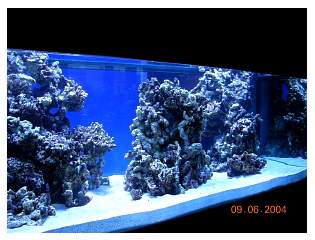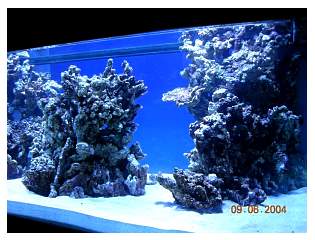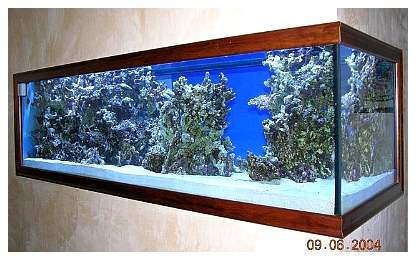|
Ramon Parellada's (devil sea)
Reef Aquarium
Introduction:
My name is Ramón
Parellada. "Devil Sea" is my nickname on the majority
of the aquarium forums where I participate. I'm a Moderator
on www.TodoMarino.com
and collaborate with the online magazine www.arrecifevivo.com.
I'd like to start by saying I'm very proud that mine is the
first Spanish aquarium to become Tank of the Month in this
grand community. It is, without a doubt, a recognition of
all the efforts we make as aquarists to stay current in this
hobby.
I've been in this marvelous hobby since 1980, when I had
my first marine aquarium: a 350 liter. Those were difficult
years; we had nothing but undergravel filters, dead corals
for decoration, canister filters and no skimmers or reactors.
We're probably better off not even mentioning the lighting
used in those days!
Fortunately, we have overcome these problems today, thanks
largely to the marvelous invention of the Internet, which
has revolutionized the dissemination of reefkeeping knowledge
and techniques while allowing us to discover and have access
to the best equipment and the latest technologies to arrive
on the market. Once again, thank you for allowing my humble
aquarium to be featured here.
System Description:
The aquarium is located in the living
room of my home as an in-wall corner installation viewable
from three sides. A side door provides access to the "equipment
room" where all the technology that supports this small
reef is located. From this room we can also see the back of
the aquarium, where we may view some peculiar specimens not
normally visible from the front and sides. This room's back
wall is painted blue, giving a fabulous sensation of depth
when viewing the aquarium from the front.
Photo courtesy of Anthony Calfo.
System Profile:
|
|
Tank: Glass, 18 mm thick 210 x 70 x 75
cm=1100 liters |
|
|
Overflow:
25 x 60 x 75 cm = 110 liters |
|
|
Sump:
90 x 60 x 40 cm = 100 liters (50%) |
|
|
Refugium:
80 x 40 x 58 cm = 185 liters |
|
|
The system's total water capacity is approximately 1500 liters.
Aquarium substrate: 200
kg of Nature's Ocean sand with an average depth of 8-10 cm
(DSB). Dissolution recently reduced this amount, so I added
9 kg of Nature's Ocean sand to replace the sand that had dissolved.
Sump substrate: 20 kg
of Nature's Ocean sand at a depth of approximately 10 cm,
forming a DSB with a surface area of only 60 x 30 cm.
Refugium substrate: 27
kg of Nature's Ocean sand at a depth of 5 cm (SSB).
Live rock: 200 kg of
excellent "polyp rock" from Indonesia, which is
very lightweight, porous and contains good coralline algae
growth. This is the best I could find available in my country.
Aquascaping:
When I designed this aquarium's decoration
my idea was to create something different. I was tired of
the typical pile of rocks full of corals lumped together.
This led me to build an aquascape based on three elements:
a reef on the left, an island in the center and a bar on the
far right. The latter was to camouflage a side wall while
leaving enough space between each element so that the equipment
room's blue rear wall would provide a grand illusion of depth.
The center island would also provide an ample natural area
for the fish to swim around. Today, the growth and addition
of corals have practically united the reefscape but still
allows fish to circumnavigate it, thereby fulfilling its original
mission.
 |
 |
 |
The system is continuously evolving. Although it is six years
old, I have completely dismantled it three times and I've
made many other changes to the distribution of pipes, pumps,
and lighting. Nonetheless, the current setup has been in place
since April 2004. Above you can see some photos of the initial
installation and the aquascaping upon setup.
A view from the backside.
Equipment:
Lighting:
-
Three Lumenarc-3 reflectors equipped with 250-watt 14,000K
Aquaconnect bulbs driven by three SFILIGOI ACLS that reproduce
the solar cycle's sunrise and sunset.
-
One Lumimaster fixture equipped with one 80-watt T5
Deltec Aquablue Plus bulb
-
Three 1-watt Aquaconnect blue moonlights
Photoperiod:
-
Metal halides - from 2:00PM to 2:00AM
-
T5 - from 3:00PM to 11:00PM
-
Moonlights - from 2:00AM to 6:00AM
The tank's photoperiod is adapted to my work schedule so
I can enjoy the tank in its entire splendor when I'm home.
Filtration:
-
Skimmer: DELTEC AP702 (a marvelous skimmer)
-
Activated carbon reactor: filled with 1000cc of ZEO-carbon,
maintained as a permanent inline fluidized filter. The
carbon is replaced every four weeks.
-
ZEOlith reactor: filled with 2.5 kg of ZEOvit, which
I've been using for about four months. The ZEOlith media
is changed every six weeks.
I would like to include a small detail that may be forgotten
if I don't mention it. Recently on our forum, www.todomarino.com,
there was an interesting discussion, "taller de skimmers
(skimmer workshop)," based on information found on a
thread
at Reef Central about skimmer optimization. I have to
admit that because of the members' kind contributions I obtained
the best operation possible from my skimmer, thereby reducing
my system's nitrate levels. Like me, many of my companions
also have improved the operation of their skimmers using these
techniques.
Circulation:
Water circulation is provided by two TUNZE 6100 pumps (12,000
liters each) controlled by a TUNZE 7095 Multicontroller, that
is responsible for reproducing the effect of flows and tides.
The return from the sump is handled by two Deltec HLP 5250
pumps.
Multicontroller (left) and refugium (right).
Refrigeration and Top-off:
Cooling is provided by an ICEcube chiller (photo right) that
will soon be replaced by a more powerful and more efficient
SFILIGOI unit. Evaporated water is topped-off from a ROWA®
reverse osmosis unit to which I've added an anti-silicate
membrane to improve water quality. The water is automatically
topped-off by a level sensor located in the sump. Fresh saltwater
for water changes is prepared in a 500 liter reservoir located
in the basement, alongside the chiller. This avoids unnecessarily
heating the equipment room. Routine water changes are facilitated
by a pump which raises water directly to the sump at the flick
of a switch.
Additives:
As mentioned, I've been using ZEOvit
for over four months so additives are limited to just this
brand and system. They are:
|
|
|
Photo courtesy of Anthony Calfo.
|
- ZEOvit (zeolith)
- ZEObac (bacteria)
- ZEOfood-7 (bacterial food)
- ZEOstart-2 (antinitrate and antiphosphate bacterias)
- ZEOcarbon (activated carbon)
- AAHC (amino acids)
- PIF (to improve coral coloration)
- PCV (coral food)
These doses are complemented by a new Deltec PF601 calcium
reactor loaded with 6 kg of ROWA®-lith
C+ and 500 grams of ZEOmag. This setup allows me to maintain
optimum water parameters. Prior to adopting the ZEOvit method
my aquarium was basically maintained with products from ROWA®
such as ROWA®phos, ROWA®carbon
and all the ROWA®life-elements
additives (Calcium, Magnesium, KH+, Trace Elements, Iodine,
and Strontium).
Water Parameters:
|
|
|
ORP controller (left) and pH controller (right).
|
- pH: ~8.04
- Specific Gravity: 1.025
- Temperature: ~25.3°C
- NO2: undetectable
- NO3: 10 mg/l
- PO4: undetectable
- SiO2: .07
- Alkalinity: 6 dKH
- Ca: 400 mg/l
- Mg: 1300 mg/l
- Redox: 452 mv
Maintenance and Feeding:
Each week I change 50 liters of water.
I use water prepared with Oceanic salt. I've found that it
dissolves instantly and doesn't cloud the water.
Feeding is reduced to two daily additions by an automatic
feeder loaded with Ocean Nutrition Formula Two and a nightly
mixture of frozen food and freeze-dried algae from this same
brand. I vary the frozen mix and the algae on a daily basis
to ensure the fish receive a variety of vitamins and complete
nutrition. Occasionally I supplement this daily diet with
amino acids or vitamins, but never on a regular basis. Instead,
it's usually to confront bouts of Ich or viral ailments.
On a weekly basis I perform a complete analysis of the aquarium's
water parameters, which are duly recorded in a log that allows
me to exhaustively track the aquarium's evolution.
Livestock:
My aquarium is characterized
by a wide variety of animals. Although the small polyped corals
are in the majority I also keep some other stony corals, soft
corals, Tridacnids and other invertebrates and of course,
fish… plenty of fish. Below is a list of all (or nearly
all) of the aquarium's inhabitants.
|
Fish:
|
|
|
-
1 Acanthurus achilles
|
-
2 Amphiprion percula
|
|
-
1 Zebrasoma xanthurus
|
-
1 Premnas biaculeatus
|
|
-
5 Zebrasomas flavescens
|
-
1 Centropyge loriculus
|
|
-
3 Pseudanthias squamipinnis
|
-
1 Pseudochromis diadema
|
|
-
8 Chromis viridis
|
-
2 Synchiropus picturatus
|
|
Invertebrates:
|
|
| -
2 Lysmata amboinensis |
-
1 Strombus lentiginosus |
| -
2 Lysmata debelius |
-
3 Ophiolepis superba |
| -
2 Stenophus hispidus |
-
2 Holothuria thymiosycia |
| -
5 Strombus luhuanus |
-
20 Paguristes cadenati |
|
-
Tridacna maxima (2), T. gigas (2)
|
|
-
50 different snail species, (Astraea,
Trochus, Tectus, Turbo, Cypraea)
|
|
LPS:
|
|
| -
2 Favia sp. |
-
1 Caulastrea furcata |
| -
2 Favites sp. |
-
1 Fungia sp. |
| -
1 Montastraea sp. |
-
1 Cycloseris sp. |
| -
1 Acanthastrea sp. |
-
1 Trachyphylia geoffroyi |
|
-
2 Euphyllia (1 parancora, 1 paradivisa)
|
|
SPS:
|
|
|
-
Anacropora sp. (1 species)
|
-
Pectinia spp. (2 species)
|
|
-
Pocillopora spp. (3 species)
|
-
Porites (2 species) nigrescens, cylindrica
|
|
-
Seriatopora spp. (2 species)
|
-
Stylophora spp. (2 species)
|
|
-
Heliophora sp. (1 specimen)
|
-
Montipora spp. (3 species) (confusa, digitata,
capricornis)
|
|
-
Acropora spp. (10 different species), over 40
pieces (valida, millepora, florida, granulosa, cervicornis,
palmata, caroliniana, humilis, monticulosa, nobilis,
efflorescence)
|
|
Other Corals:
|
|
|
-
Capnella sp. (1 specimen)
|
-
Briareum sp. (1 specimen)
|
|
-
Zoanthus spp. (various colonies)
|
-
Discosoma spp. (2 species)
|
|
-
Ricordea florida (various colonies)
|
-
Symphylia sp. (1 specimen)
|
|
-
Tubastraea sp. (1 specimen)
|
-
Xenia spp. (various colonies)
|
|
-
Clavularia sp. (1 specimen)
|
-
Sarcophyton sp. (1 specimen)
|
|
-
Gorgonia (3 species) Eunicea sp., Plexaura
sp., Swiftia sp.
|
I would like to clarify that in my country it's not easy
to acquire "wild" corals. For this reason the majority
of the pieces are aquacultured with the exception of a few
specimens I've been fortunate enough to find. I've observed
that the aquacultured SPS are slower growers. They practically
stay in a lethargic state for several months. On the other
hand, the wild pieces are faster growers and their coloration
is maintained more exactly after their arrival. The coloration
of aquacultured corals changes fairly quickly, acquiring beautiful
colors but different from their original coloration at the
time of purchase.
For this reason, with only a few exceptions, my corals are
not very large. When purchased they are barely 5 or 10 cm
and, given that my tank is still young, it's difficult to
see extraordinarily large pieces.
Acknowledgements:
This entire project would not have
been possible without the help of some of the best shops and
importers in my country that in one way or another have helped
me acquire some very special pieces. Many thanks go out to
Oscar of Coral-Reef, Emilio of Waterline, Neus of Pisciber
and, of course, Pedro of Acuapasion, who provided many of
my first pieces. Thank you all.
Additionally, I can't forget my friends. I'd like to extend
my sincere gratitude to my friends at TodoMarino.com (especially
Enrique who was kind enough to translate this article). Without
their support and advice I could never have gotten this far.
Many thanks to that grand character known as Anthony (Calfo,
that is). Thank you, too.
Feel free to comment or
ask questions about my tank in the Tank of the Month thread
on Reef Central.
|
If you'd like
to nominate a tank for Tank of the Month, click here
or use the button to the right.
|
 |
|

